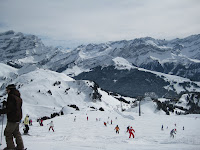 Sacre bleu, the Swiss Alps are amazing. As a mountain guy, I'm hard to impress, but Villars was truly impressive. The views were jaw-dropping, amazing, spectacular, then some. The skiing was great. And we did the whole thing without being inside of a car for one moment all day. We took a train all the way into the heart of the skiing area.
Sacre bleu, the Swiss Alps are amazing. As a mountain guy, I'm hard to impress, but Villars was truly impressive. The views were jaw-dropping, amazing, spectacular, then some. The skiing was great. And we did the whole thing without being inside of a car for one moment all day. We took a train all the way into the heart of the skiing area. From Gland, near Nyon, we trained through Lausanne and past Montreaux and the views got more and more exciting. Here's the view looking up the Rhone Valley from the train somewhere between Lausanne and Montreaux (above left). Just of hint of what's still to come.
 At Bex (right), we exited the big train, watched by some craggy peaks, and walked a few steps to le petit rouge train that winds up through picturesque villages and into snow country.
At Bex (right), we exited the big train, watched by some craggy peaks, and walked a few steps to le petit rouge train that winds up through picturesque villages and into snow country.  The views were amazing, including the impressive Dents du Midi (left) which seemed to keep watching us the entire day. We can see them (barely) from our appartment in Gland, we could see them from the train, and we could see them from the ski slopes. This view is from the place where we vowed to move to Villars and spend at least a year living in and exploring these mountains and valleys.
The views were amazing, including the impressive Dents du Midi (left) which seemed to keep watching us the entire day. We can see them (barely) from our appartment in Gland, we could see them from the train, and we could see them from the ski slopes. This view is from the place where we vowed to move to Villars and spend at least a year living in and exploring these mountains and valleys.  We took the telecabine up from Villars, and our little skiers (left) got ready for their first day skiing in the Swiss Alps.
We took the telecabine up from Villars, and our little skiers (left) got ready for their first day skiing in the Swiss Alps.  Here's the view (right) from the top of the Grand Chamossaire, at 2120 meters (about 7000 feet). We spent most of the day riding up and down the Grand Chamossaire.
Here's the view (right) from the top of the Grand Chamossaire, at 2120 meters (about 7000 feet). We spent most of the day riding up and down the Grand Chamossaire. And if that view isn't grand enough, here's another view from the Grand Chamossaire (left).
 There was a full 360 degree panorama of spectacular snowy peaks, something that even a person from the Northwestern US, land of the North Cascades and Olympic Mountains, would find impressive.
There was a full 360 degree panorama of spectacular snowy peaks, something that even a person from the Northwestern US, land of the North Cascades and Olympic Mountains, would find impressive. I can hardly wait to see more of this fabulous place I'm lucky enough to call home. I need to get back to some other highlights, like the unbelievable Jungfraujoch cog train that tunnels through the Eiger up to 3,454 meters (11,332 ft), the highest elevation train station in Europe. Tweet





























